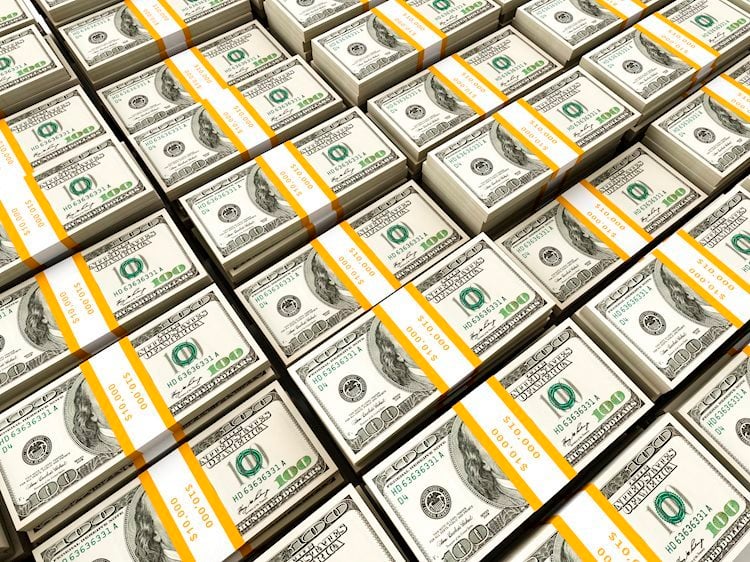
- DXY Index exhibits mild losses at 105.35, indicating a modest bearish trend.
- Market attention is centered on conservative Fed comments and April inflation expectations that could shape US Dollar outlook.
- Bets on the Fed remain steady and also lend support ot the USD.
The US Dollar Index (DXY) is trading mildly lower at 105.35 on Monday at the midpoint of the US session. The strong market odds and the Federal Reserve’s (Fed) hawkish stance toward cutting interest rates limits the losses for the US Dollar. Any possible Greenback rally predominantly depends on major US data this week, particularly April’s Consumer Price Index (CPI) on Wednesday.
The US economy continues to exhibit robust growth in Q2, underpinning the USD’s recovery following cautious Fed comments. Signals hinting at no imminent rate cuts have adjusted the market’s easing expectations, fostering a more hawkish outlook. Fed officials’ stance, while cautious, is largely data-driven, and key indicators such as CPI and Retail Sales due this week will drive the narrative.
Daily digest market movers: DXY mildly down ahead of CPI
- Fed remains vigilant, limiting USD losses. Rate cuts are not imminent with the probability of a June cut decreasing from 10% to 5% at the start of last week. Probability of a July cut reduced to approximately 25% from 40%.
- A November rate cut remains fully anticipated by the markets.
- This week is crucial with three major economic figures expected: Producer Price Index (PPI), CPI and Retail Sales. Market predictions suggest persistent inflation and robust growth in the US, which is likely to be verified by the upcoming data that would extend the Greenback’s rally.
DXY technical analysis: DXY reflects a probable bearish outlook despite bulls’ efforts
The current technical picture of the DXY shows mixed signals that lean toward a more bearish outlook. The Relative Strength Index (RSI) prominently reveals a negative slope and is entrenched in negative territory. This points to a growing dominance of selling pressure, indicative of weakened buying momentum and a potential downward trend. Simultaneously, the Moving Average Convergence Divergence (MACD) displays flat red bars, a signal that, despite a struggling bullish momentum, the bearish momentum is failing to make strong gains.
As for the Simple Moving Averages (SMAs), they exhibit intricate dynamics. The DXY is trading beneath the 20-day SMA, representing short-term bearish dominance. However, the fact that the Index still remains above both the 100 and 200-day SMAs may hint toward potential long-term bullish pressure.
US Dollar FAQs
The US Dollar (USD) is the official currency of the United States of America, and the ‘de facto’ currency of a significant number of other countries where it is found in circulation alongside local notes. It is the most heavily traded currency in the world, accounting for over 88% of all global foreign exchange turnover, or an average of $6.6 trillion in transactions per day, according to data from 2022. Following the second world war, the USD took over from the British Pound as the world’s reserve currency. For most of its history, the US Dollar was backed by Gold, until the Bretton Woods Agreement in 1971 when the Gold Standard went away.
The most important single factor impacting on the value of the US Dollar is monetary policy, which is shaped by the Federal Reserve (Fed). The Fed has two mandates: to achieve price stability (control inflation) and foster full employment. Its primary tool to achieve these two goals is by adjusting interest rates. When prices are rising too quickly and inflation is above the Fed’s 2% target, the Fed will raise rates, which helps the USD value. When inflation falls below 2% or the Unemployment Rate is too high, the Fed may lower interest rates, which weighs on the Greenback.
In extreme situations, the Federal Reserve can also print more Dollars and enact quantitative easing (QE). QE is the process by which the Fed substantially increases the flow of credit in a stuck financial system. It is a non-standard policy measure used when credit has dried up because banks will not lend to each other (out of the fear of counterparty default). It is a last resort when simply lowering interest rates is unlikely to achieve the necessary result. It was the Fed’s weapon of choice to combat the credit crunch that occurred during the Great Financial Crisis in 2008. It involves the Fed printing more Dollars and using them to buy US government bonds predominantly from financial institutions. QE usually leads to a weaker US Dollar.
Quantitative tightening (QT) is the reverse process whereby the Federal Reserve stops buying bonds from financial institutions and does not reinvest the principal from the bonds it holds maturing in new purchases. It is usually positive for the US Dollar.